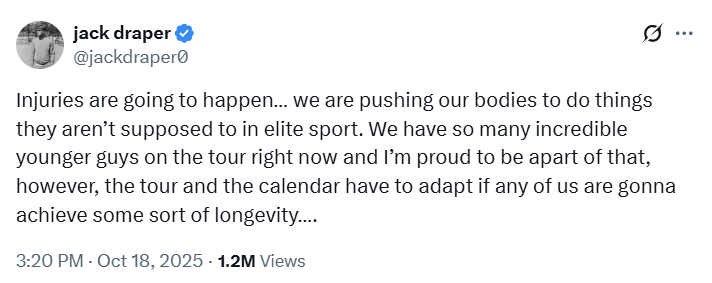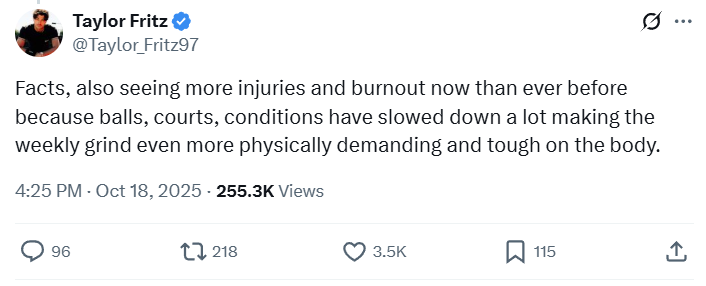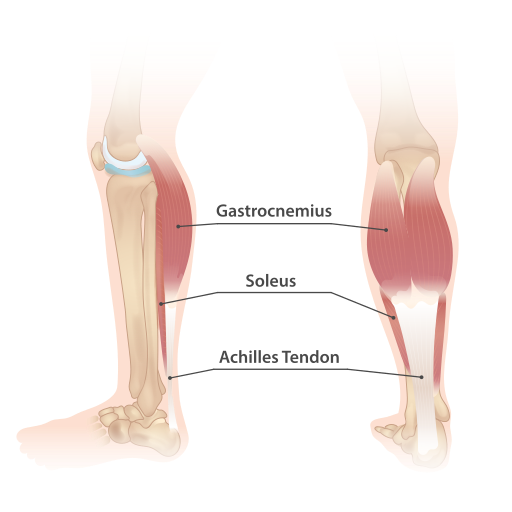Holger Rune and Why Achilles Ruptures are Rising Across Sports
An interview with orthopedic surgeon Dr. Andrew S. Bi on the increase in Achilles tendon ruptures, one of the toughest injuries in sports.
The dominant story in tennis this week has been the severe injury suffered by ATP No. 10 Holger Rune on Saturday. The 22-year-old Dane, long regarded as one of the most promising players of his generation, ruptured his Achilles tendon during a routine movement in his semifinal match at ATP 250 Stockholm last week.
Achilles ruptures can be a devastating injury for professional athletes, keeping them out of action for upwards of a year, and they’ve become increasingly visible in elite sports, with NBA stars Jayson Tatum and Tyrese Haliburton both rupturing their Achilles during the NBA Playoffs earlier this year. Haliburton’s injury was particularly brutal as it came in the deciding Game 7 of the NBA Finals, and his exit from the decisive game all but eliminated any hope his Indiana Pacers had of a championship.
Rune’s injury—and how it will derail the career of one of the most promising in the sport—led to a rallying of support for him—and also a renewed outcry— from his peers in men’s tennis.
Rune’s mother, Aneke, who travels the tour full time as his manager, also sounded off to Denmark’s BT about the schedule.
“There have simply been too many mandatory tournaments,” Aneke Rune said. “Tournaments that players are obliged to participate in, and for which they are severely penalized financially by not playing them all. The players simply do not have time to recover properly throughout the season…there is no rest, neither physically nor mentally.”
Holger Rune, who reached a career-high ranking of No. 4 in 2023, had been on the bubble for qualifying next month’s ATP Finals in Turin, and played a very full and globe-trotting schedule in recent weeks that admittedly included many optional tournaments: Davis Cup in Malaga, Laver Cup in San Francisco, ATP 500 Tokyo, and ATP 1000 Shanghai before going to ATP 250 Stockholm on a late entry.
Debates about the schedule are eternal and essential in tennis—and I plan to do a deep dive on the tour calendars on Bounces soon.
But in all the noise around this topic in the days after Rune’s injury, one thing I thought was missing was insight about this type of injury, its severity and growing frequency, and what the road could look like for a young tennis star with a ruptured Achilles.1
So to gain insight for myself and for Bounces readers, I spoke today with Dr. Andrew S. Bi, an orthopedic surgeon at NYU Langone who specializes in sports medicine and has experience—professional and personal—with Achilles ruptures.
Our conversation began, unexpectedly, with Dr. Bi telling me of his own firsthand (firstfoot?) experience with this injury.
This interview has been lightly edited and condensed for length and clarity.

Dr. Andrew S. Bi, NYU Langone: Actually it’s kind of a funny coincidence: a little bit of personal expertise is that I actually had an Achilles rupture myself in 2022, so it’s a topic near and dear to my heart.
Ben Rothenberg, Bounces: Or near and dear to your heel, at least. I’m curious now, how did yours happen?
Dr. Andrew S. Bi, NYU Langone: Yeah, I was playing basketball in our residency. In residency we have a men’s basketball league, and I was playing basketball there and it ruptured. It was a similar kind of injury to how most of them happen: a non-contact landing from a jump, on an eccentrically loaded tendon.
The most common Achilles rupture is when you’re landing from a jump: your foot is going from a position of plantar flexion—where only your toes are on the ground—to the heel on the ground, so the Achilles is lengthening.
Ben Rothenberg, Bounces: How random is this injury? After watching video of Rune’s injury—and then videos of many of the NBA Achilles injuries—most of the movements in these moments of injury seem fairly routine. These don’t look like some of the more obviously gruesome visuals where joints are clearly bending the wrong way, or whatever you may see with other sorts of severe acute injuries in sports.
Dr. Andrew S. Bi, NYU Langone: 100 percent. You see that in ACL tears or multi-ligamentous knee injuries in the NFL: the knees and legs are bending totally out of position. Or with an ankle fracture like what happened to Chris Godwin, a wide receiver on the Bucs last year, where the ankle just totally moves in the opposite direction.
Achilles ruptures most commonly happen in these eccentric contractions where the player is loading the calf or Achilles as it’s lengthening, so either landing from a jump or kind of taking a step back to start sprinting. That was, with the specific example the Tyrese Haliburton injury last year in the NBA Finals: you can see him take that step back, load that calf. That intense load while the muscle-tightening unit is stretching and getting longer is when it’s most at risk.
Ben Rothenberg, Bounces: How much is there in the way of prevention or risk assessment that could be done? I’m curious, could a doctor or physiotherapist look at one of these athletes’ legs, let’s say 24 hours before they each had their these traumatic injuries: would they have been able to say, ‘Oh wow, this Achilles is vulnerable, it’s in bad shape’? Or is it not as detectable or predictable as that?
Dr. Andrew S. Bi, NYU Langone: I mean, if we could do that, we would be hired by every professional sports team out there. (Laughs)
It really is kind of a freak accident, because players do these moves a million times across different sports and they don’t tear their Achilles. It’s just bad luck that sometimes the load is so much that the tendon gives way.
Now, you know, people can have tight gastrocsoleus, which is the calf muscle complex—they can have tight calves. They can have Achilles tendonitis, wherein the Achilles tendon, where it inserts on the heel, is inflamed and causes pain. And when that happens, teams typically know to really scale back, trying to either rest them or rehab them before they let ‘em go back to full-speed play, because those symptoms increase the risk for having an Achilles rupture.
If I remember correctly, I think Christian McCaffrey had bad Achilles tendonitis that kept him out for a decent amount of weeks last season. And that’s the reason why: because the Achilles tendon rupture is just so devastating.
Ben Rothenberg, Bounces: One of the patterns I saw in this admittedly pretty small sample set of videos I was watching—Rune, Haliburton, and Jayson Tatum—they all seemed to have some sort of preexisting strain or pain in that leg. Rune had his left thigh taped before he ruptured his left Achilles. Haliburton had a calf strain in Game 5 of the NBA Finals before rupturing his Achilles in Game 7. Tatum was wearing a sleeve on the leg he injured.
They all had something going on higher up on their leg, and they were playing through it. And so I wonder if that made them each more vulnerable? Like you said, could it lead to a dysfunctional tightening of muscles if there is something else amiss on that kinetic chain of their leg?
Dr. Andrew S. Bi, NYU Langone: Yeah, definitely. Any injury in a joint above—or below, but for the Achilles it would typically be above—any injury changes the biomechanics of how players run, jump, change direction. That predisposes you to another injury in that lower extremity. And that’s why typically, teams are so careful returning players when they do have some kind of pain or symptom bothering them.
Ben Rothenberg, Bounces: There have been several of these high-profile cases we have mentioned, but maybe you know more objective metrics beyond what could be some recency bias. Are these injuries becoming more common?
From what I was reading in my research about Achilles ruptures, they’re most common, population-wise, among men in their 30s and 40s. These recent high-profile cases were all athletes who are in their 20s. And so I just wonder if there is a trend towards this becoming more common, and if so, if you have any idea what might be causing this this increase?
Dr. Andrew S. Bi, NYU Langone: Yeah, that’s a great question. Typically, just like you said, these injuries happen to, like, weekend warriors—people who haven’t worked out a lot and aren’t physically in-shape and then go out and try and run sprints or play basketball and jump, and rupture their Achilles on the weekends. But, just like you said, we’ve seen such a rash of these across all professional sports.
It’s kind of funny, we actually published a paper on this in the journal KSSTA in 2023. We published this paper with one of the senior foot-and-ankle specialists, Dr. John Kennedy—he’s pretty internationally renowned in foot-and-ankle sports medicine. Basically, we’d initially thought [an increase in Achilles ruptures] was kind of related to that COVID layoff. Everyone was off from 1-2 years from organized sports, and we thought that significant layoff was what led to like a significant increase in the Achilles ruptures we were seeing in the general public—as well as in the NFL, for those first two seasons after COVID. We haven’t updated the study since, but it does seem like this trend is continuing.
So, you know, I don’t have a good answer. It could be because players of all sports are just getting bigger, stronger, faster, and they’re just putting loads on tendons that are not evolving as fast as sports performance is increasing. That could be why we’re seeing such an increase in these injuries.
A good parallel is actually in the MLB with pitchers: the average speed of a pitch has just increased dramatically over the past couple decades—insane amounts of change in pitching performance. And the UCL (ulnar collateral ligament), which is the ligament that is the main stabilizer to the pitching motion on the elbow, it’s not evolving fast enough to withstand these loads, so we’re seeing a significant increase in UCL tears in pitchers at all levels. It’s almost inevitable that’s a pitcher is going to have a UCL injury of some sort, just because of the speeds and demands that they’re putting on that ligament.
Ben Rothenberg, Bounces: That makes sense.
On Rune’s injury specifically, he described his injury as “full broken on the proximal part.” I guess there’s different ways in which you can rupture your Achilles; what does his description indicate to you about the relative severity of his rupture, and what would the recovery look like for a “full broken” proximal Achilles?
Dr. Andrew S. Bi, NYU Langone: So to best answer that question, a little background on the anatomy: the Achilles is this big tendon that inserts on the calcaneus (heel bone). It’s approximately 7 to 10 centimeters in length, and then it becomes the muscle of the calf.
And so when he says it ruptured “fully, proximally,” that’s what we typically call a myotendinous tear of the Achilles, so at the proximal—or higher up— portion of the tendon, where the muscle becomes tendon.
You can also have mid-substance tendon tears, which is right in the middle of the tendon—it just rips apart. And you can have distal, which is farther down the extremity, closer to the heel. You can have distal avulsions where the tendon pulls off the calcaneus.
The most common are these proximal ruptures, these proximal myotendinous tears. Actually, in the general public—especially those who aren’t athletically inclined and may be in their 40s, 50s, they just walk for exercise or lift weights and they don’t do too much high demand activity— recent studies have actually shown very good results with non-surgical treatment of their ruptures. They get them into rehab really soon, they start loading the tendon early. And even though it seems crazy, these tendons—especially these proximal myotendinous ruptures—they heal well and patients do well without surgery.
Now, the caveat to that is with a professional athlete, you place totally different demands on the Achilles. And if you need high athletic performance from your Achilles, surgical repair is still superior to non-surgical repair, because you can generate more force after a year with the surgery.
Ben Rothenberg, Bounces: What would be the timeline, in your experience, for an athlete coming back to training and then to competition from an Achilles rupture like this?
Dr. Andrew S. Bi, NYU Langone: I’m a little biased, again (because of personal experience with this injury), but the Achilles is probably one of the toughest musculoskeletal injuries to come back from to peak athletic performance. Your entire body loads through this one tendon at the bottom of your foot, and tendons, in general, heal slower than bones.
And so, at minimum, it’s a one-year return to sports. But I can tell you, personally and from patients that I’ve treated and that we’ve seen over the years, even though they can return after a year, their strength is not at 100 percent after a year. They don’t perform to their exact [previous] level until, typically, like 18 months, almost even two years.
Obviously Haliburton and Tatum are in their recovery phase right now, but prior players—Kobe Bryant, Kevin Durant—when they come back, you can always see in that first year back, which already a year after injury, their performances are just nowhere near their baseline.
But then in the second year of play, which is two years after injury, you can see people starting to get more confidence and getting back at their baseline level of play.
Ben Rothenberg, Bounces: So it can be a long road, and I especially have to imagine that in an individual sport like tennis it’s got to be even tougher, since you can’t adjust or modify your play as you work on a comeback as much as a team player might be able to ease back into competition.
Dr. Andrew S. Bi, NYU Langone: So, so tough. I mean, the demands that these professional tennis players are placing on their Achilles—cutting, pivoting, accelerating—and totally on an island, in front of everybody. Yeah, it’s got to be super hard.
Ben Rothenberg, Bounces: After this injury, there’s been a ton of talk from Rune’s peers—and his mom, who’s his manager—about the tennis calendar, saying that the schedule is too packed and too tough.
So to their point: how much is overuse a factor in an injury like this? Maybe it’s obvious to say that it would cause more wear and tear and strain on a leg to be playing more often, but yeah, how much is rest a clear preventative measure for injuries of this sort?
Dr. Andrew S. Bi, NYU Langone: Yeah, the appropriate amount of rest after loading any tendon or muscle is critical to prevent injury. And especially in sports like tennis where it’s nearly year-round and there’s not a long, dedicated off-season. Even what there is, players are still playing and training in the off-season. It definitely can place a big load on the tendon and increase the risk for injury.
Ben Rothenberg, Bounces: Yeah, I guess that’s what we saw with Haliburton, too: it was Game 7 of the NBA Finals, so he was at his maximum mileage point over the course of a season at that point.
Dr. Andrew S. Bi, NYU Langone: Yeah, and they were playing that NBA season after playing in Olympic basketball, so no off-season.
It’s a lot on these guys. It’s a lot to ask of your musculoskeletal system.
Thanks to Dr. Bi for his insights, thanks to you for reading Bounces, and please stay safe and healthy, folks! -Ben
(Away from the spotlight, 42-year-old retired tennis star Kim Clijsters also ruptured her Achilles earlier this month during a Legends tournament in Luxembourg.)






Excellent & timely.
Excellent work! I have one question. He talked at the edges of this, but I don’t think directly. Are there any stretches or exercises that one can do to make a rupture, or Achilles tendinitis, less likely?